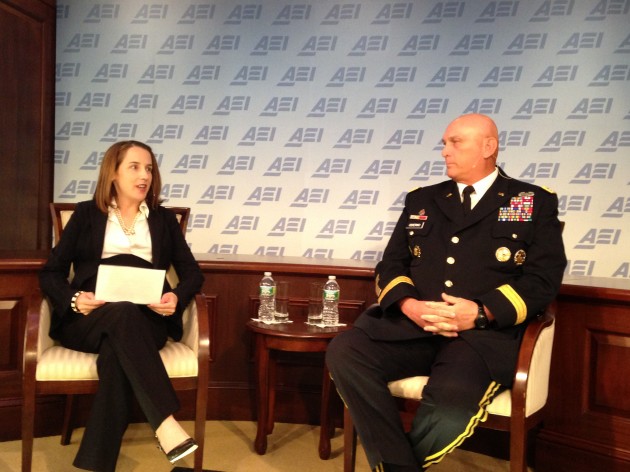Pay Raise, Sequester Cut Will Eat Army Budget, GCV At Risk: Gen. Odierno
Posted on

BreakingDefense contributor Mackenzie Eaglen quizzes Army Gen. Ray Odierno this morning at AEI.
By voting to raise troops’ pay at almost twice the rate the Pentagon has requested, the House of Representatives risks suffocating other defense priorities, from combat training to much-needed weapons programs like the Army’s flagship Ground Combat Vehicle, Chief of the Staff of the Army Gen. Ray Odierno said today.
“We made a recommendation this year for a military pay raise of 1 percent; [the] House passed 1.8 [percent],” Odierno said during a talk at the conservative American Enterprise Institute this morning.
It’s worth noting that the Senate Armed Services Committee has stuck with the 1 percent raise, although the full Senate has not yet voted. This may make a very interesting battle during conference. Our bet is on this coming out closer to the Senate position.
1.8 percent versus 1.0, “That sounds like a little difference; but it’s a huge difference throughout the years,” said Odierno. It’s billions of dollars.”
“We’re trying to work with Congress on this, but if we continue to have higher-level pay raises it’s going to become really a problem for us,” Odierno told his AEI interlocutor, MacKenzie Eaglen, who herself has written extensively on this intra-military version of guns-vs-butter.
So, one reporter asked, is the Army wargaming budget scenarios that, for example, cut even the cherished (albeit controversial) GCV? “Because of the sequestration cuts, we have to consider everything,” Odierno said. “We have to look very hard at all our modernization programs; I’m very concerned about it.”
As the defense budget grew post-9/11, pay and benefits’ share of the Army budget roughly doubled to 46 percent, Odierno said. Now it’s on track to double again in the next decade — while the budget shrinks. “If we continue along the way that we are going now, we believe by 2023, 80 percent of our budget’s going to be [spent] on compensation,” he said. “We can’t operate on that.”
With personnel the most expensive single item in the Army budget and cost per soldier inexorably on the rise, Odierno would like to fit his force into a tightening budget by having fewer people. But the Army just can’t lay people off like a Detroit automaker. It takes either time or big buy-outs to ease troops out in large numbers. That means shedding people is a money-losing proposition in the short term.
But Odierno must produce results in the short term because the automatic cuts known as sequestration slice the Pentagon’s annual budget by $50 billion, effective when the 2014 fiscal year begins Oct. 1st. (Sequestration already took effect in 2013 but at a slightly lower level). Odierno, Defense Secretary Chuck Hagel, and other Pentagon leaders have begged Congress for more time to phase in sequester savings, but barring a political miracle, they have to cut either training or equipment or, most likely, both.
The Army has already cancelled major training exercises for 78 percent of its combat brigades. The fully trained 22 percent are mostly in or headed for Afghanistan, leaving little margin of error for other crises. “What keeps me up at night is if I’m asked to deploy 20,000 soldiers somewhere,” said Odierno. “I’m not sure I can guarantee they’re trained to the level that I think they should be because of the way sequestration’s being enacted.”
If there’s a crisis, he said, “yes, we’ll still send soldiers, yes, we’ll be able train them — to a lower level…It probably means more casualties.”
Military readiness has felt the sequester bite immediately, because training and maintenance are paid for month by month. Research, development, and procurement are long-term contracts with months or even years of buffer room before the full impact is felt, but felt it will be.
While various upgraded communications systems are collectively the Army’s top priority, the GCV is the service’s biggest single program — and has come in for criticism as heavy as its 60-plus-ton weight. “I will say we need the Ground Combat Vehicle, and we have to have it. Now, we might have to delay it because of budget cuts,” Odierno went on. “I don’t know; we haven’t made the decision yet.
The GCV is meant to replace the 1979-vintage Bradley Infantry Fighting Vehicle, a heavily armed but relatively lightly armored troop carrier with a 25 mm gun, anti-tank missiles, and passenger room for six or seven very cramped foot soldiers: GCV will have much more armor, a slightly larger gun (but no missiles), and room for nine infantrymen with all their gear. “The Bradley Fighting Vehicle just didn’t perform the way we wanted it to [post-9/11],” Odierno said. “Our soldiers were vulnerable; they didn’t have the mobility. We need something that is better….The issue’s going to be how quickly are we going to get there now because of budget cuts.”
Subscribe to our newsletter
Promotions, new products and sales. Directly to your inbox.
